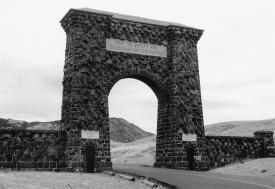Janet Chapple's Blog, page 14
August 22, 2015
Celebrating the National Park Service’s 99th birthday—in a couple of ways
First I want to pass along the fact that next Tuesday, August 25th, is the NPS’s birthday. The good news is that all national park entrance fees will be waived that day. So, if you have time to visit a park that’s not too far from you and can stay only one day, that would be a good day to go.
Next, I hope many people who normally read my blog posts have been visiting Yellowstone or another park this month, since there’s been nothing new to read on this website since August first. Editor Beth has been both flying and sailing (but not in Yellowstone), while author Janet has stayed earthbound and had time to catch up on work that needs doing for her next Yellowstone book. This new book will be a historical anthology full of good things to read and look at. So I’m celebrating the NPS birthday by beginning to reveal bit by bit what’s in my new book as we approach next spring’s publication date. I’ve mentioned the upcoming book twice before on my blog; on October 6, 2014, and March 3, 2015, I was calling it Magnificent Playground: Early Yellowstone in Words and Watercolors, but now we’ve decided on a title that gives a better idea of what’s in the book.
Through the Yellowstone by Bicycle, Covered Wagon, Foot, Horseback, and Skis offers a potpourri of historical articles that are both important to Yellowstone history and fun to read. There are ten major stories in this book but also several short selections—what I call snippets of information and historical ambience. All will give readers a feeling for the gradual change in the ways of enjoying, using, and also studying the world’s first national park. The selections span the time between establishment of Yellowstone National Park in 1872 and the country’s entry into World War One.
I’ll let you know as the months go by more about what Through the Yellowstone contains, but today I want to tell you about one of the amazing people we feature who have contributed to the park’s history.
~ ~ ~
Here’s the headline of a one-page article, in which the editors saw fit to honor a woman resident of New York City who was an avid horsewoman.
In the early 1900s Mrs. Robert C. Morris (Alice Parmelee Morris) had become enamored with the scenery of Yellowstone Park and spent many summers at the Silver Tip Ranch just north of the park. Then in 1917 Mrs. Morris conceived, financed, and carried out her remarkable plan to explore and map an interconnected loop of trails throughout the park and its environs. At that time Yellowstone Park trails totaled about 400 miles—but not all were suitable for equestrian traffic. Mrs. Morris spent four summer months leading her pack train throughout the park. She presented a twenty-nine-page typed report, “Notes on Trail Study in Yellowstone Park 1917,” to Park Supervisor Chester A. Lindsley. Included with the report was a detailed and professionally produced map showing the proposed trails, which we will reproduce along with the New York Times article in the anthology.
So what became of this report that Mrs. Morris worked out so carefully? No evidence of action taken on her work turns up in a search of Yellowstone Park archives. One can speculate, however, that there could have been several reasons for this.
First, lack of funds: a request to Congress for $50,000 for a system of trails and bridle paths in Yellowstone went nowhere. This is not surprising—the bill was submitted on the exact date of President Woodrow Wilson’s request to Congress for a declaration of war with Germany: April 2, 1917.
Second, administrative turmoil between the National Park Service and Yellowstone: in 1917 and 1918 there was disagreement as to which agency was in charge of roads and trails, since the NPS (created in 1916) was gradually replacing the U.S. Army Corps of Engineers for such construction projects.
Third, low priority: automobiles had almost completely replaced horses in the park. In 1918, for example, among the park’s 35,039 tourists, only 808 came in horse-drawn vehicles. The number of people who came on horseback is not recorded but must have been very small.
Fourth, two other Yellowstone enthusiasts contributed their own plans to the park administration: long-time park employee Milton P. Skinner and pack-trip leader Howard Eaton had both worked on the question of improving the trails, and both submitted plans. Mrs. Morris’s plan was scarcely acknowledged. Some money must have been found for trails after the war, however, since in 1923 a complete system of trails was dedicated to Howard Eaton.
August 1, 2015
Those noisy contraptions can now enter Yellowstone Park!
It’s August 1, 1915.
“Hooray! Today we can finally drive our new automobile into Yellowstone National Park.” Something like this must have been shouted between the open-topped cars lined up to pass through the North Entrance Arch on the first day it was legal to “motor” through the park.[Turns out we showed you that arch in our July 28th post.]
It’s true that a man named Henry G. Merry from nearby Horr, Montana had decided thirteen years before, in 1902, to “pilot the car [a Winton] to the fort and talk things over with the commandant,” according to Merry’s son’s account many years later. 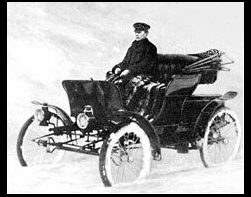
You see, the Secretary of the Interior and superintendent Colonel John Pitcher had agreed that year that automobiles must be banned from the park due to the terrible condition of the roads and the danger of frightening the horses. But Merry went anyway—and was told he was under arrest and would have to pay a penalty. However, according to son Edward T. Merry: “When my father asked what the penalty would be, the officer very seriously replied, ‘You will have to take me for a ride in this contraption.’” But soon Merry was ushered out with a warning never to try it again.
Officials knew they would eventually have to improve the roads enough for cars to use them, and eventually this was done. Exactly one hundred years ago today the new era began. Fifty Fords, Buicks, Wintons, Haynes, and others entered the park. Within a year it was obvious that horses and autos were incompatible on the bumpy, narrow roads, and of course, the horses lost the contest.
[My source for this story was The Yellowstone Story, Volume II, by Aubrey L. Haynes, pages 264 to 269. The late 1890s Winton touring car is courtesy of Wikipedia commons.]
July 28, 2015
Follow-up on summer 2015 road construction
Photo by Leslie Kilduff, page 252 of Yellowstone Treasures.
While the construction near Gardiner around the North Entrance Arch will be ongoing right up to the centennial of the National Park Service on August 25, 2016, there is a total road closure at night you need to be aware of if you are making a trip this summer.The section of the Grand Loop Road from Mammoth Hot Springs to Norris Junction is closed to all travel every night, from 11 p.m.-7 a.m., seven days per week. Also, expect 30-minute delays when traveling between Norris and Golden Gate.
As always, current road information is available by phone: 307-344-2117.
July 24, 2015
Updates in the second printing
As promised, here are some of the updates we included in Yellowstone Treasures, Updated Fourth Edition, in the second printing this summer. You should get a sense for the level of detail in the book, as well as learning a bit of news.
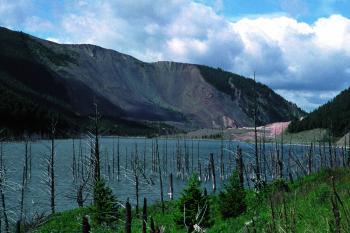
Quake Lake was created by a huge landslide (Yellowstone Treasures, page 36).
If you’re entering or leaving the park via the West Entrance, it’s worthwhile to make time to visit Earthquake Lake, northwest of West Yellowstone on U.S. 287. The picture here, taken by Bruno Giletti, is the same one you will find in the book. We rewrote the description to tell you the Gallatin Forest visitor center was remodeled in 2014. It displays interesting exhibits about the 1959 earthquake and landslide that killed 28 people, and how a potential Madison River flood was avoided.
Janet revised a bunch of the geyser information based on data from the Geyser Observation and Study Association and the folks at geysertimes.org (see our Yellowstone Links page for information about those organizations). Here are the changes in the Upper Geyser Basin descriptions:
Oblong Geyser’s eruption interval went from three to seven hours to four to six (see page 92 of the guidebook).
Giantess Geyser had no eruptions between October 2011 and January 30, 2014. Their rarity means you will be lucky to see one when you visit. By the way, you might enjoy this five-minute edited video of the October 13, 2004 eruption.
Daisy Geyser’s eruption interval went from about two-and-a-half hours in 2012 to about two to three hours in late 2014 (p. 101).
Changes in what you can see when you visit led Janet to revise some wording. At West Thumb Geyser Basin, when you get to the lakeshore near Lakeside Spring you used to be able to see a remnant of concrete that supported a boat dock long ago. Now you can’t really see that, so we changed the sentence to be more informative and say “A boat dock for the Zillah, which ferried passengers to Lake Hotel from 1890 to 1907, was located here” (p. 141).
Also, when you stand at Uncle Tom’s Overlook on the South Rim Drive you can no longer see little Crystal Falls of Cascade Creek as easily across the canyon, because branches obscure the view (p. 180).
It’s interesting to see what a long-time observer of the park notices, isn’t it?
—Editor Beth Chapple
July 17, 2015
Upper Terrace Drive at Mammoth closed due to thermal activity
Recently some tiny but active terrace-forming springs have made their appearance very close to the Upper Terrace Drive. Now park geologist Hank Heasler has determined that water up to 152 degrees Fahrenheit (67 ºC) is bubbling out near the road. News sources say the feature became visibly active in May and is creating new small terraces too close to the drive for visitor safety. As a result the Park Service has closed the road.
When I visited early one morning in mid June, checking up on one of my favorite features, Canary Spring, I noticed that the area around Grassy Spring seemed very hot, with little terraces appearing since I was last there and a tiny new spring above the first major parking area, where I usually park to visit Canary.
If you’re visiting Mammoth this summer or fall, you can still park just outside the entrance to the Upper Terrace Drive and walk down the Canary Spring boardwalk or beyond the new hot activity to see my other favorite feature, Narrow Gauge Terrace.
For more about Mammoth Hot Springs and a video of Canary’s activity last year, see my September 18, 2014, post. Here’s what the spring and terrace looked like in 2009: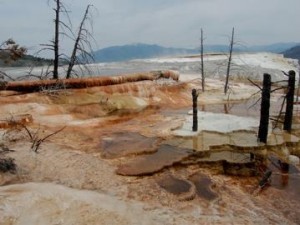
Canary looked like this when I was there in 2009.
You can locate the features mentioned here in Yellowstone Treasures (print version, map page 265 and text pages 271 to 274) or check it out in the e-book version of that guidebook. You can also find information about this part of Mammoth in our companion/derivative e-book, Visiting Geyserland, pages 11 to 15.
July 11, 2015
Guidebook printed on FSC paper for the first time
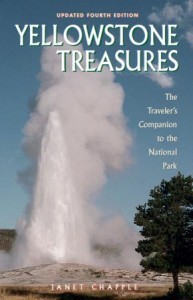 For the second printing of Yellowstone Treasures, updated fourth edition, we made a few changes. A big one is the paper itself, which is now FSC-certified. This means the paper has been sourced in an environmentally-friendly, socially responsible, and economically viable manner. Below is our Facebook post about this milestone. Over the next few weeks we will let you know about other improvements, which are so numerous we decided to add “Newly revised in 2015” to the title page.
For the second printing of Yellowstone Treasures, updated fourth edition, we made a few changes. A big one is the paper itself, which is now FSC-certified. This means the paper has been sourced in an environmentally-friendly, socially responsible, and economically viable manner. Below is our Facebook post about this milestone. Over the next few weeks we will let you know about other improvements, which are so numerous we decided to add “Newly revised in 2015” to the title page.
—Editor Beth Chapple
On this date we received the new printing of Yellowstone Treasures, 4th ed., in our warehouse. For the first time our printer, C & C Joint Printing, had Forest Stewardship Council (FSC) certified paper available for the guidebook. We are pleased that the paper and cover are from post-consumer waste, reclaimed wood, and/or controlled forests.
Posted by Granite Peak Publications on Friday, July 10, 2015
June 30, 2015
What’s New, Fun, and Interesting in Yellowstone This Summer?
Entering Yellowstone from the North Entrance may be a little tough going and not aesthetically pleasing for most of this year [2015], since there’s a humongous construction project going on to completely revamp the entrance area at the little town of Gardiner. But five miles and a thousand feet up the road to the south is Mammoth Hot Springs, and, in addition to seeing the springs along the Upper Terrace Road, I recommend spending an hour or so at the redone Albright Visitor Center. It has excellent hands-on dioramas of all of the park’s bigger mammals and kiosks for park orientation on the first floor. In the basement level, completely accessible with a new elevator, are great historical displays and the restrooms. For more about this see the Yellowstone Insider’s recent article.
One of Upper Geyser Basin’s most popular sites is the wonderfully regular Riverside Geyser. It almost always erupts every six to six-and-one-half hours. Here is the eruption I caught on my all-too-short visit to the park in mid June.
http://www.yellowstonetreasures.com/wp-content/uploads/2015/06/ynp-riverside-geyser.mp4
You can hear (1) a geyser gazer transmit by FRS radio the time of eruption to the Old Faithful Visitor Center, (2) the excited crowd,(3) the swishing of the main eruption, and (4) the rumbling of the side spouter that always accompanies Riverside’s eruptions. It always erupts quite a bit longer than this little video, which was edited for Granite Peak Publications by Jens Paape.
You can reach Artemisia Geyser’s beautiful pool and formation in one of two ways.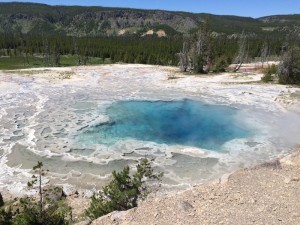 One is by walking beyond Riverside Geyser about half a mile up what used to be the main road and is now a rather rough trail past Morning Glory Pool (page 95 in Yellowstone Treasures) or by parking at Biscuit Basin and crossing the road to reach the other end of the trail from Morning Glory Pool. Up the hill in the distance in my picture is Hillside Springs, which old-time stagecoach drivers called Tomato Soup Springs.
One is by walking beyond Riverside Geyser about half a mile up what used to be the main road and is now a rather rough trail past Morning Glory Pool (page 95 in Yellowstone Treasures) or by parking at Biscuit Basin and crossing the road to reach the other end of the trail from Morning Glory Pool. Up the hill in the distance in my picture is Hillside Springs, which old-time stagecoach drivers called Tomato Soup Springs.
I did not see any grizzly bears on this trip, but there are now enough of them in the Greater Yellowstone Ecosystem so that visitors are seeing them quite frequently. The national media covered the recent very unusual event where a grizzly climbed on the hood and sides of an occupied car, leaving some scratches but giving the occupants of the car the thrill of their lifetime and their own video.
One thrill of this visit for me was being assigned for three nights to what has to be the best room in the Old House of Old Faithful Inn (Room 229). It was inside the farthest east of the five dormer windows that span the third floor front of the inn. Two mornings I awoke to a swishing sound, opened the side window, and there was Old Faithful Geyser erupting for my private enjoyment!
For fishermen and others interested in what is happening with the fish in Yellowstone Lake these days, take a look at the Great Falls Tribune’s story about the good news regarding the struggle against illegally introduced lake trout.
June 16, 2015
Summer sale on Visiting Geyserland ebook!
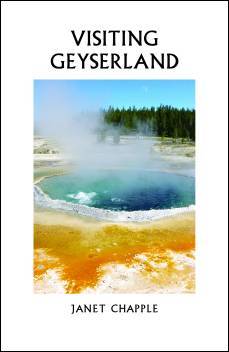 We recently improved Visiting Geyserland, adding more direct links to the geyser routes and maps. Visiting Geyserland is our guide to the geysers and hot springs in the ten Yellowstone geyser basins and other hydrothermal areas convenient to the roads. It’s handy to have the geyser walks at your fingertips on your phone or tablet when you are in Yellowstone. You can zoom in close to the maps and use the hyperlinks to jump to the correct section of the trails as you choose to follow them.
We recently improved Visiting Geyserland, adding more direct links to the geyser routes and maps. Visiting Geyserland is our guide to the geysers and hot springs in the ten Yellowstone geyser basins and other hydrothermal areas convenient to the roads. It’s handy to have the geyser walks at your fingertips on your phone or tablet when you are in Yellowstone. You can zoom in close to the maps and use the hyperlinks to jump to the correct section of the trails as you choose to follow them.
All summer we are offering this short ebook at $4.99, discounted from the list price of $8.49. The Buy now button on the Visiting Geyserland page takes you to our distributor IPG, where you can choose the format that works for you: ePub, Kindle, or PDF. Might be a good way to introduce a friend to Yellowstone Treasures!
—Editor Beth
June 9, 2015
Heads-up on summer road construction
For anyone who’s planning a trip to Yellowstone in the next couple of months, the good news is that the Isa Lake bridge between Old Faithful Village and the West Thumb of Yellowstone Lake is opening this Thursday, June 11, after total reconstruction. Landscaping projects will be ongoing until about September 10 causing some delays, but at least you will no longer have to take a big detour to go between those two popular points.
All summer, however, there will be delays up to 30 minutes between Mammoth Hot Springs and the Norris Campground. I’m going to try to avoid that stretch except for once during my time in the park (June 11 to 16).
The total revamp of the Gardiner area around the North Entrance Arch will also be going on for the indefinite future—that is, they are hoping to complete the first phase of it in time for the celebration of the centennial of the National Park Service on August 25, 2016. Here’s where to find more information about this project.
Current road information is available by phone: 307-344-2117.
June 4, 2015
Enjoying Geyser Eruptions, 1939 to Today
The countdown to my getting back to Yellowstone is down to seven days now, and the excitement grows! Anticipating seeing my favorite geysers and places and visiting with friends while I do it, I can hardly wait. So there’s lots to be done before I leave, and maybe you’ll forgive me if I go back eight years to a blog post I wrote when I was still blogging on Amazon.
In those blog posts I was reminiscing about my unforgettable four childhood summers (beginning in 1939) at Old Faithful, where my father was working in the Inn as Transportation Agent, and my mother took my sister and me to wonderful places, always driving, since she didn’t like to walk. So, from 2007, here goes. . . .
Two geysers we saw quite often when I got to live at Old Faithful were Great Fountain and Lone Star, both accessible by road in those days. We would take a lunch and a book or our game of Parcheesi and drive out north or south to wait for these geysers to erupt. It seems to me we would often have them to ourselves. 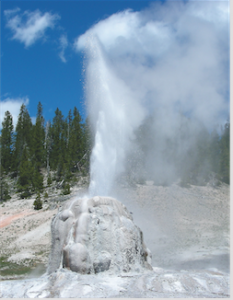 To the left is Lone Star Geyser by Barbara Lasseter, from Yellowstone Treasures, page 106.
To the left is Lone Star Geyser by Barbara Lasseter, from Yellowstone Treasures, page 106.
The most thrilling geyser viewing experience I can remember was being roused in the night to drive over to see Giant erupt. Daddy took me on his shoulders so I could see over the crowd. Somehow, the group excitement made more of an impression than the actual eruption! According to George Marler’s Inventory of Thermal Features, the first half of the 1940s was a relatively quiet time for Giant, so I was privileged to be there at an eruption. And the next time I got to see one was on July 3rd, 2006—again with a lot of excited viewers. Recently Giant has been erupting quite reliably every few days and thrilling hundreds of us. [Oops! Not these years. Giant hasn’t erupted since 2008.] You can sometimes even see the huge steam cloud from its eruptions on the Old Faithful Webcam.
It wasn’t until I was an adult that I learned there are actually hundreds of active geysers in Yellowstone, maybe 500 of them, but changing all the time. Each one has its own shape, size, and personality. There are many “geyser gazers” who go to the park only to watch and study the geysers.

